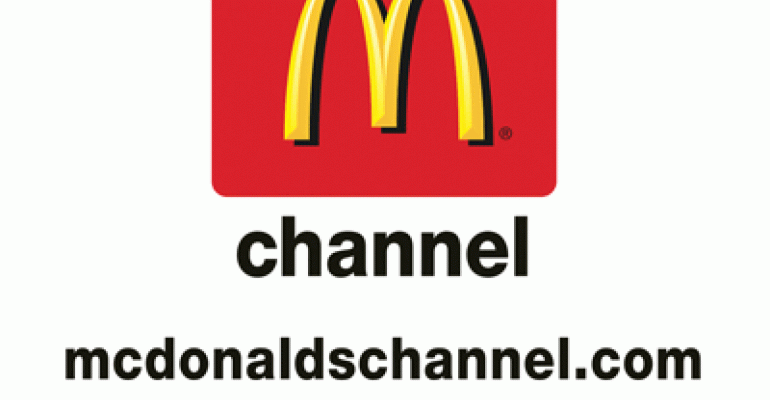McDonald’s forthcoming in-restaurant TV channel will break new ground in building business-to-consumer relationships, one of its developers said.
The McDonald’s Channel, a digital out-of-home network, will be tested in about 650 company-owned and franchisee-operated McDonald’s restaurants in southern and central California beginning this quarter, said Lee Edmondson, chief executive of ChannelPort Communications LLC, which is developing the channel. It stems from an initial trial at 25 locations begun more than two years ago.
Edmondson recently spoke with Nation’s Restaurant News about the channel’s business model and its content plans.
What can you tell me about the business model for the McDonald’s Channel and the relationship between McDonald’s and ChannelPort?
The key is that these screens can add to the [guest] experience, and they can add to the brand and McDonald’s, and other brands can tell a different story in this environment than they could on traditional television and on the Internet. We found that there was a significant interest in all kinds of stories if they were done in a much more subtle way … if we were story telling, as opposed to advertising.
It is clearly not intended to be something for McDonald’s to chat away at its customer … In fact, the minute and a half McDonald’s will use will probably be story lines about what they are doing at Ronald McDonald House Charities, or … “How do you make a Big Mac.”
How will the McDonald’s Channel make money?
There are approximately eight minutes of traditional advertising available in an hour, which is about half of what you’d see typically on cable TV … What we’re moving towards in our business model is to give large brands — like a Coke, like a Visa, like an AT&T — an opportunity to think about this television channel in a different way and think about being in the content business and entertaining the customer and being much more subtle with the specific brand engagement.
It also gives us a tremendous opportunity to work with the [movie] studios in their green band [approved for all audiences] trailers and in their longer form trailers. So rather than a 30-second trailer that you might see on network TV, on the McDonald’s Channel, you might see two minutes or even longer.
How will McDonald’s convince advertisers that such advertising will yield results for them?
It will begin with faith and evolve towards metrics. We will be investing a significant amount of resources to build these metrics and provide analytics. I think we will develop a very compelling story and the quantitative data will validate that story.
Continued from page 1
When you talk about the interactive relationship between in-restaurant content on the McDonald’s Channel and [sister website] mcdonaldschannel.com, do you envision that as a real-time activity?
You might only see a minute to two minutes of a piece of content, but then can go to mcdonaldschannel.com to have a much deeper relationship with that particular piece of content, and get behind the scenes into certain blogs, or whatever the consumer might want to do.
An example of that is to picture that J Lo might be coming out with her newest music video. The McDonald’s channel could provide 15 to 30 seconds of an introduction to that music video and the consumer could go to the website and see the full video.
That’s the great thing about McDonald’s offering free WiFi: The channel itself will certainly adopt that strategy and invite the consumer to participate [in the restaurant].
What about the channel’s navigational tools?
It has an interactive nature to it, and it also has a navigation component to it that tells the consumer when they walk in what they’re watching and very quickly gives them a synopsis of what the future content is because you may be interested in today’s news, I might be interested in today’s sports and my wife might be interested in what the latest fashion news is. So, if I sit down and I see that in seven minutes from now the sports highlights are going to be on, then I’ll sit and watch. Or, if I don’t want to wait that long, I’ll go to mcdonaldschannel.com if I have my computer. Or, if I have my mobile [device], I’ll go to mcdonaldschannel.mobi and go into that specific content that I’m interested in.
When you say ChannelPort was created to deliver the McDonald’s Channel, will it handle all aspects of this? Is it a turnkey operation for the franchisees?
If you look at so many of these out-of-home channels, [they are] almost completely independent of the DNA of the brand that they are in. I’m not completely convinced that is the best way to do it.
In such situations, does a business with a digital out of home network become just another viewing place for [standard] content?
I’m not sure the world needs another place to just watch the same content you can see everywhere else. But I do think that the world is open to the aspiration that, maybe I can see something different, and maybe I can see something that is of interest to me.
I believe that is who we are and what McDonald’s is all about, and I think that is what is going to differentiate the McDonald’s Channel from what is out in the marketplace.
Contact Alan J. Liddle at [email protected].
Follow him on Twitter: @AJ_NRN

